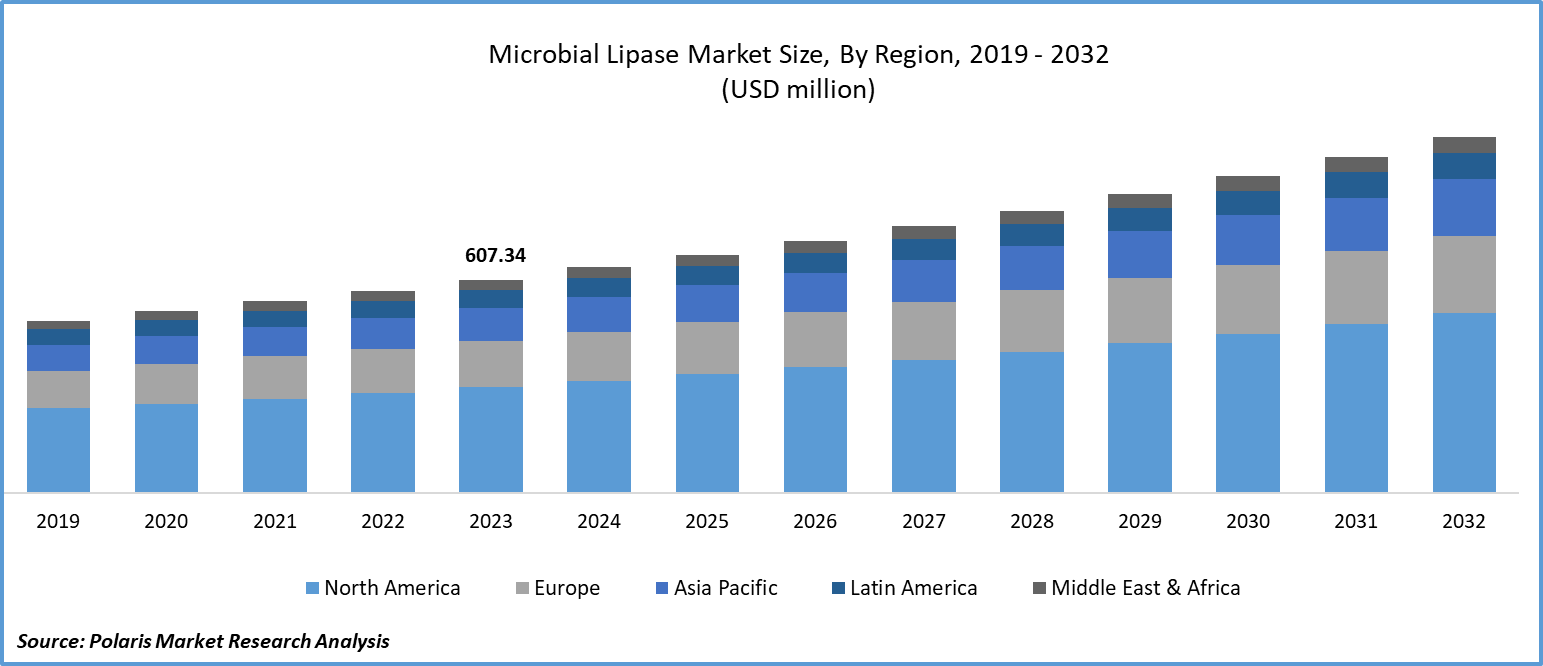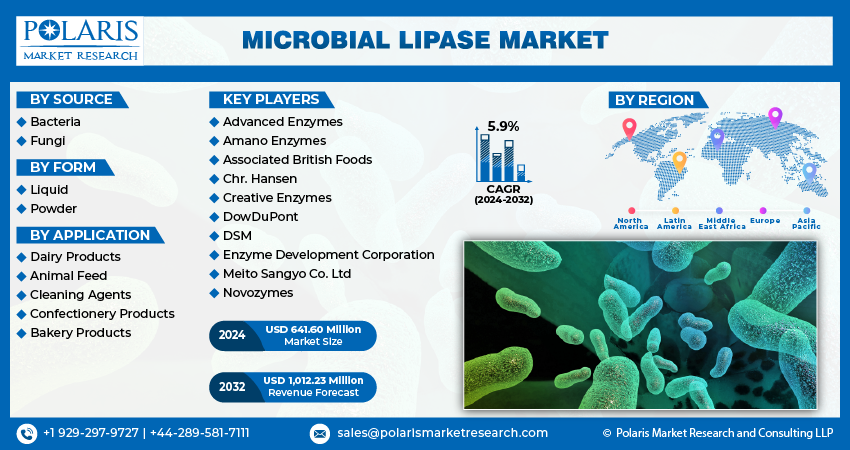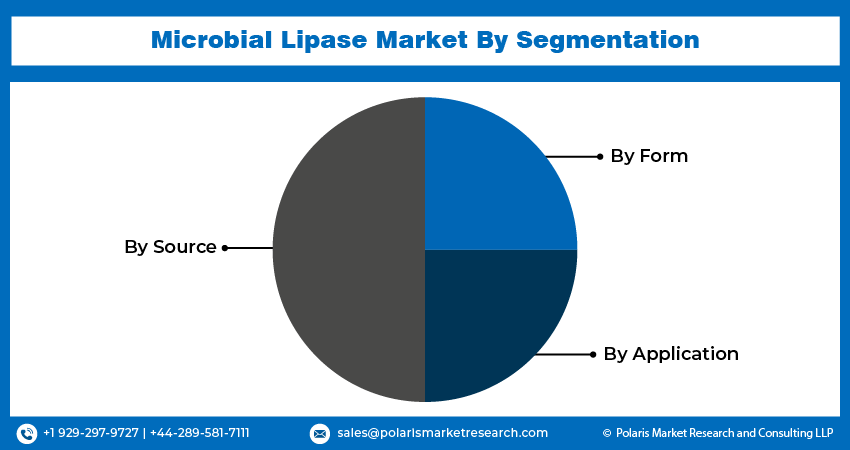
Microbial Lipase Market Share, Size, Trends, Industry Analysis Report, By Source; By Form; By Application (Dairy Products, Cleaning Agents, Bakery Items, Confectionery Items); By Region; Segment Forecasts, 2024 - 2032
- Published Date:Mar-2024
- Pages: 119
- Format: PDF
- Report ID: PM4788
- Base Year: 2023
- Historical Data: 2019-2022
Report Outlook
Global microbial lipase market size was valued at USD 607.34 million in 2023. The market is anticipated to grow from USD 641.60 million in 2024 to USD 1,012.23 million by 2032, exhibiting the CAGR of 5.9% during the forecast period.
Market Overview
The market is experiencing growth propelled by rising awareness concerning animal health and the quality of animal products. Additionally, there is an uptick in the consumption of enzyme-modified cheese (EMC) & enzyme-modified dairy ingredients (EMDI). Furthermore, the market is benefiting from the advantages offered by microbial lipases compared to those derived from animal and plant sources. As a result, the demand for lipases, especially those from microbial origins, is anticipated to surge owing to their versatile applications across various food processing activities in the foreseeable future.

To Understand More About this Research: Request a Free Sample Report
Lipase enzymatic biosensors play a crucial role in various analytical methods applied across different sectors, including environmental science, the food industry, bio-degradable polymers, oleo-chemicals, and as the diagnostic tools for detecting cholesterol & triglyceride levels in blood samples. For instance, Cetyl-trimethyl ammonium bromide inhibits lipase derived from the Bacillus Cereus, Cadmium-II inhibits lipase from Yarrowia lipolytica, & cobalt-II inhibits lipase from Mycobacterium tuberculosis. Additionally, lipases are also utilized in constructing electrochemical & optical biosensors, broadening the scope of biosensors.
Microorganisms possess the ability to efficiently biodegrade lipid waste under mild conditions, producing lipolytic enzymes more effectively than traditional lipid degradation methods, thereby promoting environmental sustainability. An emerging aspect in the current scenario is the hydrolysis of ester bond-containing synthetic plastics, pesticides, insecticides, and parabens, which contributes to the production of bioenergy and energy conservation for managing global hazardous wastes.
Additionally, microbial lipases play a crucial role in producing high-value-added products through enzymatic catalysis, which consumes less energy. They are also evolving rapidly as candidates for designing therapeutic and diagnostic aids. In pharmaceutical and medicinal applications, lipase enzymes serve as modulators, acting as activators and inhibitors, particularly in managing lifestyle diseases like obesity. The impact of modulators on therapeutics is significant presently and is expected to grow further in the future. Therefore, the prominent utilization of lipases enhances various biotechnology-based productions across diverse sectors.
The global demand for microbial lipase has surged owing to its versatile applications across various industries. These enzymes find extensive use in industrial cleaners, leather processing, detergent manufacturing, and cosmetics. Moreover, their significance extends to bioremediation, biomedical applications, biodiesel production, and pesticide formulations.
Moreover, there is a growing awareness among cooperatives and farmers in animal husbandry regarding the benefits of incorporating microbial lipase into regular animal health practices, which is driving market growth. Furthermore, increased demand for microbial lipase from confectionery companies engaged in confection production, coupled with heightened research and development endeavors aimed at enhancing microbial lipase-based products, is poised to fuel market expansion in the foreseeable future.
Growth Factors
Wide application in food and beverages
In the food industry, microbial lipases find extensive application due to their specificity towards substrates. They operate effectively under mild conditions and exhibit high stability in organic solvents. Various types of lipases, including lysophos-pholipase, phospholipase, and triacylglycerol lipase, are commonly utilized in food processing. They play key roles in modifying flavors by synthesizing esters of short-chain fatty acids and selectively hydrolyzing fat triglycerides to release free fatty acids. Moreover, they contribute to reducing fat content in food products like meat and fish, resulting in leaner options. Additionally, lipases are essential during the fermentation stage of sausage production, where they manipulate long-chain fatty acids released during ripening.
Commercial utilization of Lipases
Recently, microbial biotechnologists have shifted their focus toward the commercial utilization of lipases derived from microorganisms, leading to the selection and characterization of numerous microbiological strains for enzyme production. Candida Rugose, Penicillium, Rhizopus, Aspergillus Niger, & Pseudomonas stand out as the most employed microorganisms in industrial lipase synthesis due to their potential lipase sources. Technologies such as reversed micellar systems, aqueous two-phase systems, and immune purification methods are employed for the cost-effective synthesis of large quantities of microbial lipase suitable for industrial purposes.
Restraining Factor
Lack of standardization and regulations
The absence of clarity in patent protection regulations concerning microbial lipase across various countries, coupled with the lack of standardized regulatory frameworks and policies, could disrupt supply dynamics and challenge the market. Furthermore, a shortage of awareness regarding the advanced applications of microbial lipases limits their potential impact. Moreover, the presence of substitutes for microbial lipase further constrains market growth.

Report Segmentation
The market is primarily segmented based on source, form, application, and region.
|
By Source |
By Form |
By Application |
By Region |
|
|
|
|
To Understand the Scope of this Report: Speak to Analyst
By Form Insights
The powder segment held the majority microbial lipase market share in 2023
The powder segment held the majority of the microbial lipase market share. This significant market presence can be attributed to several factors. Firstly, powdered microbial lipase products offer convenience and ease of storage, making them preferred by manufacturers across various industries, including food and beverage, pharmaceuticals, and biotechnology. Additionally, powdered lipase enzymes demonstrate enhanced stability and shelf-life compared to other forms, ensuring prolonged efficacy in diverse applications. The growing demand for microbial lipase in food processing, particularly in cheese production and flavor enhancement, further fueled the dominance of the powder segment in the market landscape, solidifying its position as a key contributor to market growth and expansion.
By Application Insights
The cleaning agents segment captured the largest microbial lipase market share in 2023
The cleaning agents segment captured the largest microbial lipase market share. This is largely driven by the rising demand for microbial lipase enzymes from companies specializing in the development of cleaning agents. Additionally, the segment's growth is propelled by ongoing innovations within the detergents industry, particularly the adoption of microbial lipases as alternatives to chlorine bleach. These innovations are anticipated to sustain the segment's growth trajectory in the foreseeable future.

Regional Insights
North America dominated the microbial lipase market share in 2023
North America dominated the global market with a microbial lipase market share. The region’s dominance is driven by the increasing utilization of enzymes across various sectors, including animal feed, dairy products, cleaning supplies, and toiletries. Moreover, the region witnessed a surge in demand for cheese and other dairy items, propelled by the preferences of major restaurant chains. Consequently, the region's escalating cheese consumption is expected to drive market growth.Top of Form
Asia Pacific will grow at the fastest pace. This growth is attributed to the presence of several prominent microbial lipase manufacturers in the region and the rising adoption of lipase enzymes. Evolving dietary patterns in the region have resulted in heightened consumption of dairy products. Additionally, increasing awareness about personal hygiene, growing concerns regarding the spread of infectious diseases, and the emphasis on sterilizing household and industrial surfaces further contribute to this growth trend.

Key Market Players & Competitive Insights
The global lipase market is characterized by intense competition and fragmentation. Given the diverse applications of lipase across various end-user industries, key players are focusing on expanding their production facilities and innovating products to capture substantial market share globally. Furthermore, several major players are extending their global footprint by acquiring smaller manufacturers in foreign markets.
Some of the major players operating in the global market include:
- Advanced Enzymes
- Amano Enzymes
- Associated British Foods
- Chr. Hansen
- Creative Enzymes
- DowDuPont
- DSM
- Enzyme Development Corporation
- Meito Sangyo Co. Ltd
- Novozymes
Recent Developments in the Industry
- In August 2023, the FDA approved the expanded use of RELiZORB, developed by Alcresta Therapeutics, to facilitate enteral feeding in children aged 2 to 5. This regulatory approval is anticipated to bolster market growth positively.
Report Coverage
The microbial lipase market report emphasizes key regions across the globe to help users better understand the product. It also provides market insights into recent developments and trends and analyzes the technologies that are gaining traction around the globe. Furthermore, the report covers an in-depth qualitative analysis of various paradigm shifts associated with the transformation of these solutions.
The report provides a detailed analysis of the market while focusing on various key aspects such as competitive analysis, source, form, application, and futuristic growth opportunities.
Microbial Lipase Market Report Scope
|
Report Attributes |
Details |
|
Market size value in 2024 |
USD 641.60 million |
|
Revenue Forecast in 2032 |
USD 1,012.23 million |
|
CAGR |
5.9% from 2024 – 2032 |
|
Base year |
2023 |
|
Historical data |
2019 – 2022 |
|
Forecast period |
2024 – 2032 |
|
Quantitative units |
Revenue in USD million and CAGR from 2024 to 2032 |
|
Segments Covered |
|
|
Regional scope |
|
|
Competitive Landscape |
|
|
Report Format |
|
|
Customization |
Report customization as per your requirements with respect to countries, regions, and segmentation. |
FAQ's
key companies in Microbial Lipase Market are Advanced Enzymes, Amano Enzymes, Associated British Foods
Microbial Lipase market exhibiting the CAGR of 5.9% during the forecast period.
The Microbial Lipase Market report covering key segments are source, form, application, and region.
key driving factors in Microbial Lipase Market are Wide application in food and beverages
The global microbial lipase market size is expected to reach USD 1,012.23 million by 2032
